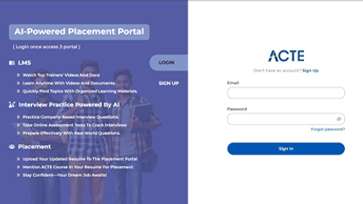ACTE's python training course gives you an insight and in-depth skill in the development of python codes and packages such as SciPy, Matplotlib, Pandas (scientific teaching), Scikit-Larn, NumPy, internet scraping libraries, and the Lambda function. Business professionals want to create the most efficient employment in highly qualified MNCs throughout the course material.
As part of this training, you may participate in real-time initiatives and tasks that have a great impact on the actual world of business so that your careers are easy for you.
Additional Info
Introduction of Data Science with Python:
Python Data Science course enables you to study from scratch these ideas and helps master vital Python programming concepts, such as data processing, file operations as well as object-oriented programming and different Python libraries, such as Pandas, Numpy, and Matplotlib. This course in Python for Data Science will also assist you to grasp the many kinds of machine learning, recommendation systems, and many more data science topics to begin your career in data science.
The Python Data Science course will teach you the fundamentals of Python programming. You will learn Data Analysis, Machine Learning, Data Visualization, Web Scraping, and Natural Language Processing (NLP) as part of this Data Science with Python certification program. After completing this course, you will have mastered the fundamental tools of Data Science with Python.
Who can Learn Data Science with Python:
Long recognized from a syntactic point of view, Python is a straightforward computer language. Python offers also a large range of libraries and resources in an active community. You have a platform to utilize with new technologies, such as machine learning and data science.
Data science professionals don't want to get caught up in complex programming needs. They would like to make hassle-free usage of programming languages such as Python and Ruby. Ruby is good with various data pre-processing chores, for example in data clearing and data munging. However, there are not as many libraries for machine learning as for Python.
In terms of data science and machine learning, Python is therefore given the edge. In addition, Python allows developers to build programs and execute prototypes to speed up the development process. Once the project has been transformed into an analytical tool or application, it can if necessary be transferred to more advanced languages such as Java or C.
New data scientists are gravitating to Python because of its user-friendly approach. So popular indeed, Python is regarded as their favorite programming language by a stunning 48% of data scientists with five or fewer years of expertise. This number is reduced by the rise in the degree of experience and analysis. For data researchers, Python proved to be an ideal starting point.
Why is Python preferred for information science?
Python is the programming language of choice for everyday activities addressed by data scientists and one of the industry's leading data science tools. Python is frequently the perfect choice for data scientists who need to put statistical code into production databases or to connect data with web-based applications. It is also suitable for algorithms, which data scientists typically need to perform.
There are other Python packages designed especially for specific functions, such as pandas, NumPy, and SciPy. Python's sci-kit-learn is a helpful and important tool for data scientists working on various machine learning projects. Another Python library, Matplotlib, is an excellent choice for data science applications that require graphics and other visualizations. When the code is written in a fluid and natural style, it is referred to be 'Pythonic.' Aside from that, Python is well-known for additional characteristics that have piqued the interest of the data science community.
Why does Python matter to the analysis of data?
It is soft. If you want to do something innovative which has never happened before, Python is the right choice for you. It is great for developing apps and websites that wish to be scripted.
It's Simple to Understand. Its emphasis on simplicity and readability results in a smooth and relatively low learning curve. A python is a great tool for novice programmers due to its ease of use. Python gives programmers the advantage of needing fewer lines of code to perform things than older languages require. In other words, you spend less time dealing with code and more time playing with it.
Open source It is Python is open-source, which implies that it is free and employs a development approach for the community. Python is suited for Windows and Linux applications. It may also be readily transported to many platforms. There are several Python open-source libraries, for example, data manipulation, data viewing, statistics, mathematics, machine learning, and natural language processing (though see below for more about this).
It has a lot of support. Anything that can go wrong will go wrong, and if you're utilizing something for which you didn't have to pay, finding help might be difficult. Python, fortunately, has a big following and is widely used in academic and industry circles, thus there are many helpful analytics libraries accessible. Python users in need of assistance may always rely on Stack Overflow, mailing groups, and user-contributed code and documentation. And as Python grows in popularity, more users will submit information about their user experiences, resulting in additional free help material. This results in a self-perpetuating spiral of acceptability by an increasing number of people.
Certification Of Data Science with Python:
ACTE gives you a certificate of industry-recognized completion with everlasting validity once you successfully finish the data science with Python coursework. AnalytixLabs certification is widely respected in the industry, thanks to our well-established domain knowledge and renowned customers in India and internationally. We must maintain the dignity of our accreditation procedure as the highest-class Data Science Institute of India.
You will only receive a diploma after presenting a compulsory project work and assessing it fairly as part of your training course. For these tasks and projects, there is no pass/fail. In case the assignments and projects are not up to date, trainees should be invited to provide improvisation assistance and support. However, throughout the evaluation, no sort of plagiarism is permitted.
Except for MCQ exams, there is no pass/fail for these tasks and projects. In the case of the dual certification program, you will have two chances to pass the MCQ tests. Our goal is to provide trainees with valuable hands-on experience so that they are well-prepared for job interviews and perform effectively at their employment.
Career Growth Of Data Science with Python:
Our courses are designed to prevent preconditions and no previous experience. Masters of compulsory technical abilities for data scientists such as Python and objective and functions. You will also learn essential libraries like scientists learning, Matplotlib, NumPy, and pandas along the course. Furthermore, in our Python data science course, find out all you need to know about web scraping and SQL queries.
Most data science programs end there since they are the only skills required to become a data scientist, but we went a step beyond. To help you stand out from the crowd, we added ideas like the UNIX command line, Git, and Github to foster cooperation and efficiency.
We at Dataquest understand how difficult it is to navigate a completely new professional path, therefore we educate uniquely. Our classes are always hands-on and engaging. Say goodbye to long, boring videos. With Dataquest, you'll be creating and running actual code regularly, verifying your new abilities. If you get stuck, we'll help you get back on track. The data scientist curriculum is structured as follows:
- Our career in Python data science includes a range of courses, including an introduction to Python for beginners throughout their careers to advanced Python for data science.
- You will write actual code and reply to challenges in practice which will allow you to grasp certain competencies needed for data science.
- At the end of each session, you will finish a guided project to apply your new abilities to present potential employers while constructing your portfolio.
- Upon each training, you will receive a certificate which you can share or use to strengthen your résumé with your professional network.
- You are armed with all the abilities needed to become a data scientist after completion of the whole program.
Industry Trends in Data Science with Python:
TensorFlow - TensorFlow is perhaps a library for superior numerical calculations with around 35000 comments and a lively collection of some 500 contributors. It is utilized in several sectors of science. TensorFlow is a framework for the description and operation of tensor calculations that measure machine objects partially described, which finally provide a value. Better display of the machine graph. Reduces neural machine learning errors by 50 to 60 p.c. Smooth library management, parallel computing to perform complex models.
SciPy (Scientific Python) - SciPy (Scientific Python) is another free and ASCII text file Python library for knowledge research that is widely used for high-level calculations. Zippy has about nineteen repositories on GitHub and a thriving community of around 600 people. It is widely used for scientific and technical computations since it extends NumPy and provides a variety of simple and cost-effective algorithms for scientific calculations. Algorithms and functions are written in Python using the NumPy module. Commands for manipulating knowledge and mental images at the highest levels. SciPy image submodule for multidimensional image processing.
NumPy — NumPy (numerical python) provides a strong N-dimensional array object as the fundamental computer package in Python. There are about 18000 comments on GitHub and a vibrant 700-person community. It is a generic array processing program with better flat objects known as arrays and tools. In addition, NumPy partially solves the sluggish disadvantage by offering such flat arrays as the supply of features and operators with efficiency.
Matplotlib - Matplotlib provides strong but visually appealing visualizations. It's a Python charting package with over 26,000 comments on GitHub and a thriving community of 700 developers. It is often used for information mental because of the graphs and charts that it generates. It also has an object-oriented API in case you wish to include such graphs in your apps.
PyTorch – PyTorch is a Python-based scientific computing package using the strength of graphics processing units, and the next item in the list of the top Python libraries for data science. PyTorch is one of the most popular profound learning systems for research designed to give maximum flexibility and speed.
BeautifulSoup is a successful Python package for data science. This is another popular Python module, well known for internet creep and information scraping. Users will collect information that square measure given on some website without a suitable CSV or API, and BeautifulSoup will assist them in scraping it and preparing it in the desired format.
Roles and Responsibilities of Data Scienxce with Python:
Management: The data scientist performs an unimportant management function in supporting the building of the database of futuristic and technological skills to support various planned and ongoing data analyses.
Analytics: The data scientist has a scientific role in planning, implementing, and evaluating high-level statistics and strategies for application in the most complicated business challenges. For different issues, such as projections, classification, clustering, pattern analysis, sampling, simulation, etc., the data scientist creates economic and statistical models.
Strategy/Design: The Data Scientist is critical in the creation of creative strategies to understand the firm's customer trends and management, as well as methods to address complex business issues, such as the optimization of product fulfillment and overall profit.
Collaboration: The Data Scientist's duty is not a lonely one, and in this position, he collaborates with superior data scientists to convey challenges and results to key stakeholders to improve company performance and decision-making.
Knowledge: The Data Scientist is also leading the way in exploring various technologies and techniques to provide novel data-driven insights at the most agile possible rate for the company. In this case, the data scientist also takes the initiative to analyze and use new and better business data science methodologies that he provides to the SCO.
Additional Duty:A data scientist also undertakes associated responsibilities and tasks as the senior data scientist, the data science director, the data manager, or the employer assigns.
Tools of Data Science with Python:
- SAS
- Hadoop is an acronym for Apache Hadoop
- Tableau
- TensorFlow
- BigML
- Knime
- RapidMiner
- Excel
- Flink (Apache)
- PowerBI
- DataRobot
- Spark is an acronym for Apache Spark
- Sap Hana is an abbreviation for Sap Hana
- MongoDB
- Python
- Trifacta
- Minitab
- Kafka (Apache)
- QlikView
- MicroStrategy
- Google Analytics is a web analytics service
- Julia
- SPSS
- MATLAB
Advantages of Data Science with Python:
1.Simplicity:
- The first thing that comes to mind when talking of Python's appeal in programming and data science is its simplicity.
- The inherent simplicity and accessibility of Python make it a beginner-friendly language is one of the finest characteristics. Its clear syntax offers a shorter learning curve than most other languages.
- You could build a program in Python much faster than you might write in other languages like C ++ or Java.
- Python saves time by allowing you to jump right into the study without having to spend hours reading documentation. Python is now widely used for data analysis, statistical analysis, web development, text processing, and a variety of other tasks.
2. Bibliothèques — for every need, there's one:
- While the simplicity of Python makes it the first pick for many, its wonderful library assortment makes it even more tempting to specialists in the data sciences. Over the years, the addition of libraries that further expand its capabilities has enriched Python. You are confident you will find so many libraries tailor-made to meet your data science requirements.
- In the field of data science, NumPy is one of the early libraries. It has high-level arithmetic functions operating on multi-dimensional arrays and matrices and is ideal for scientific computation.
- SciPy is the scientific counterpart of NumPy.
- It includes all of the instruments needed for numerical integration and successful scientific data processing.
- Matplotlib is a 2D-plotting package that includes all of the tools required for data visualization.
- Scikit-Learn and PyBrain are machine learning libraries that provide modules for building neural networks.
- Other libraries include SymPy (statistical applications); Shogun, PyLearn2, and PyMC (machine learning); Bokeh, ggplot, Plotly, prettyplotlib, and seaborn (data visualization and plotting); and csvkit, PyTables, and SQLite3 (data processing and storage), to mention a few.
3. An approach to multiparadigm:
- A good feature about Python is that it is a multi-paradigm programming language, as opposed to OOP languages.
- For example, you would have to build a separate OO class in Java to print 'Hello World,' but you don't have to do so in Python. Python offers functional, procedural, and object-based programming as well as aspect-driven approaches, with a multi-paradigm approach.
4. Integration of Enterprise application (EAI):
- Python is a good platform for the integration of business applications (EAI).
- As already said, even in other programming languages, Python is strongly integrated into applications.
- This makes the web development process easier to integrate with other languages.
- You may, for example, invoke components of CORBA/COM and also call Java, C++, and C code directly and directly. Python's excellent Java, C, and C++ interoperability make it an ideal application scripting solution.
- A python is also a helpful tool for software testing because of its strong text processing and integration capabilities. It includes its unit testing framework and may also be used to create complex GUI desktop apps.
5. The Jupyter Notebook is the fifth item on the list:
- Every Python coder is familiar with The Jupyter Notebook.
- It is a free and open-source online tool that allows programmers to write expressive code.
- The Jupyter Notebook is a useful tool for Data Science and Machine Learning.
- It allows you to present your findings and integrate the outcomes (visualizations) in the same document as your code.
- The Jupyter Notebook is one of the numerous services offered by the Google Colaboratory that allows you to use free cloud services and high-performance GPUs for running the Jupyter Notebook.
- You may save your data and notes on your Google Drive as Google Colab is synchronized seamlessly with Google Drive applications.
6. There is always someone to rely on in the community:
- The Python community will always be there for you, for better or for worse. There is no difficulty, problem, or query that Python fans and volunteers will not fix or answer.
- All you have to do is inquire.
- One of the most admirable characteristics of open-source communities is that they are constantly open to discussion.
- To summarise, Python has shown to be a game-changer in the field of data science.
- It is so full of valuable tools and features that it is the first pick of many Data Scientists and Data Analysts all around the world.
- While we are sure that the arguments listed above are sufficient to demonstrate the benefits of Python for Data Science.
Placement of Data Science with Python:
Python is one of the world's most innovative information science programming frameworks. It is also one of the easiest languages of programming once it has the capacity. There is, however, still a significant disparity between supply and demand for python experts. In Bharat alone, but all across the world, the ability gap does not exist. Even the most important coding companies in India do not have the required Python resources. While language quality has gained, the desire in pursuing a course or certification is still not adequate this capacity to start a profession is not enough.
Python developer: This is one of the most straightforward professions that you may hope to obtain if you use this skill. The statistics shown in the preceding section demonstrate unequivocally that there will always be open Python developer roles to fill. Create websites to address information concerns, analytics, and build technology that is reusable and cost-effective. Optimize information algorithms to implement data protection and security.
Benefits of Data science with Python:
A python is a clever tool with a broad variety of advantages in the field of data science. It is versatile and always evolving because it is open-source. Moreover, Python offers an array of helpful libraries that may be incorporated in addition to existing structures with other languages (such as Java). Short narrative - A python is a great tool in data science.
The first of Python's several benefits in knowledge is its simplicity. Whereas certain scientists come back with a technological background or recognize different programming languages, they have several statistical backgrounds, arithmetics, or other techniques, and after entering the field of knowledge science they should not have the maximum number of cryptography expertise. Python's syntax is easy to read and write, which makes it easy to start and learn rapidly.
If the sheer number of people using Python isn't enough to convince you of its relevance in knowledge science, maybe the libraries available to make knowledge science cryptography simpler can. In Python, a library might be a collection of modules with pre-built code to help with common tasks. They essentially allow the United States to benefit from and rely on the labor of others. Some knowledge science activities would be difficult and time-consuming to code from scratch in other languages. In Python, there are several libraries available such as NumPy, Pandas, and Matplotlib to generate knowledge cleaning, knowledge analysis, knowledge visual picture, and machine learning.
Skills of Data Science with Python:
A good data scientist's coding abilities, along with statistical understanding and the capacity to think critically. Some of the data scientist talents required in data science which will benefit from great job possibilities are:
- Program Language: Applied mathematics and statistics for R/Python/Java.
- Hadoopand's work knowledge Machine Learning & Neural Networks: SQL and NoSQL databases.
- Expertise in the framework of profound learning: Keras, Pytorch TensorFlow.
- Knowledge of creative thought & industry.
- Visualizing Data.
- Mining and analysis of data.
- Mixing & Manipulation of Data.
- Analysis and modeling of statistics.
- Modeling predictive.
- Data Analysis Python.
Pay Scale for Cyber Security
- Knowledge of R followed by Python is the most significant and desired ability.
- In India alone, Python's salary pledges INR 10.2 lakhs.
- The combination of big data and data science improves the income of a data analyst by 26% compared to only one field in which he is competent.
- Between INR 9.1-10.8 lakhs, SAS users are compensated compared to INR 7.3 lakhs earned by SPSS specialists.
- Machine learning wages in India begin in the range of 3.5 lakhs INR to go up to 16 lakhs INR if you progress in this sector.
- Python is one of the most recommended languages in ML, and Python developer salaries are among the top in India.
- In India alone, Python's salary pledges INR 10.2 lakhs.
- In comparison with the expertise in only one field, the combined understanding of big data and data science raises a data analyst's compensation by 26 percent.
- Between INR 9.1-10.8 lakhs, SAS users are compensated compared to INR 7.3 lakhs earned by SPSS specialists.
- An extensive understanding of Artificial Intelligence can help you advance in your profession.
- If you are new to the field, the Artificial Intelligence pay in India is not less than 5-6 lakh INR.































